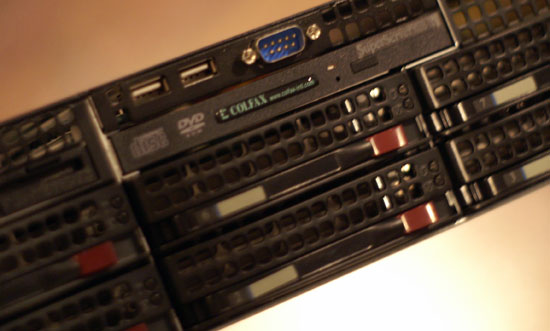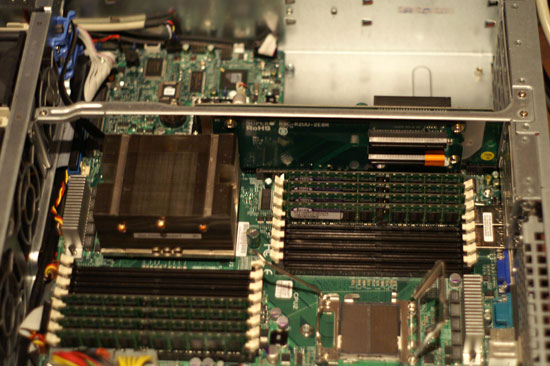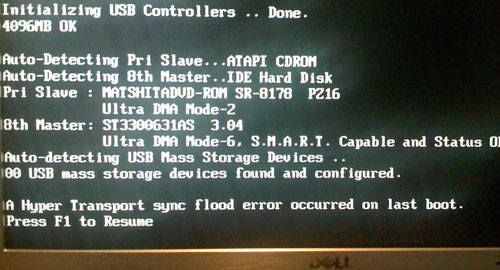AMD Phenom Preview: Barcelona Desktop Benchmarks
by Anand Lal Shimpi on September 10, 2007 12:03 AM EST- Posted in
- CPUs
The Servers
AMD was kind enough to send us two servers, identically configured, from Colfax. The configurations were as follows:
| AMD | Intel | |
| Motherboard | Supermicro H8DMU+ | Supermicro X7DBE+ |
| BIOS Revision | DMU8157v3.ROM | R1.3C |
| CPU | 2 x Opteron 2350 (2.0GHz) | 2 x Xeon 5345 (2.3GHz) |
| Memory | 8GB (8 x 1GB DDR2-667) | 8GB (8 x 1GB FBDIMM-667) |
| Hard Disk | 1 x Seagate Barracuda ES (400GB) | 1 x Seagate Barracuda ES (400GB) |
| Power Supply | 700W Redundant | 700W Redundant |
| OS | Windows Server 2003 SP1, 64-bit | Windows Server 2003 SP1, 64-bit |
These are standard Socket-1207 servers, meaning they don't take advantage of the split power-planes of Barcelona. Newer motherboards (such as the one Johan used in his tests) will support split power-planes, allowing Barcelona to run its North Bridge at a higher clock frequency, thus improving memory performance. Note that our desktop benchmarks were run under Windows Vista Ultimate (32-bit). Update: AMD has confirmed that these motherboards are Socket-1207+ and thus support split power-planes. We apologize for the error.

2U Colfax server

Colfax Intel Server

Colfax AMD Server, one CPU removed
Both systems worked just fine, but we did spend more time with the AMD system (obviously). During our testing we'd occasionally get a Hyper Transport error upon reboot, but it was intermittent and didn't interfere with our results:

Then, at the very end (literally two hours before publication) of our benchmarking, the AMD server stopped POSTing. As of now the system will simply sit there and spin its fans without actually putting anything on the screen. A number of things could have happened, but thankfully the Barcelona system decided to die after we ran all of our tests.
The take away point here is that AMD is working as quickly as possible to push out this Barcelona release. While AMD states to expect availability as early as today, we're concerned about the maturity of these platforms. We got our test systems on Friday, if this were truly a large, widespread launch we would've had hardware long ago. Whereas everyone and their mom already has a sample of Intel's 45nm CPUs, Barcelona continues to be tough to come by and performance hasn't been anywhere near final until now.
Logistics aside, we now have final silicon in hand (and a dead server on our floor), so let's see what we can do.










70 Comments
View All Comments
MadBoris - Wednesday, September 12, 2007 - link
Good catch, thx. Even though I said 'lower is better', I swapped it in my mind.So K10 looks much worse than K8 single core in that test.
I wonder where that penalty comes from and if it will pronounced in other apps.
Visual - Monday, September 10, 2007 - link
I have a question about RAM types. Are the slots different for normal unregistered DDR2, registered DDR2, and FBDIMM DDR2?If any of those are the same slots, what happens if you mess up and put the wrong type?
And I also have a suggestion for you Anand. Try testing with ASUS L1N64-SLI WS motherboard. It is originally for the QuadFX line of processors from AMD, but apparently the old K8 socket-f opterons work just fine in it, with unregistered DDR2. I assume the newer Barcelona opterons will too.
MadBoris - Monday, September 10, 2007 - link
Good preview Anand...Nice closing summary that put's it in a nutshell.
Too bad you couldn't drop a q6600 into that socket instead of just a k10 for a comparison that we all are looking forward to. ;)
Considering it isn't coming to desktop for a while, no biggie, it will be compared when it matters.
What is the huge deal in AMD not being able to get to high frequencies, I don't understand?
3ghz was in range many years ago for Intel, AMD still has difficulty getting parts out at 3Ghz. I lack the understanding if it's just manufacturing limits/costs or is it more due to their architecture limitations (interconnects and such).
This is the part that is really scarry. Intel who had profits in the 5bil range last quarter, can literally drive AMD into the ground by outpricing and outperforming them. Even if Intel decides to start losing money with a hugely aggressive price/performance ratio that is hard to pass up, AMD would not be able to withstand that onslaught for long...Question is does Intel have the blood lust to ring the death knoll once and for all and try to drive them into the ground. The saving grace here really is the high end server market with 2 and 4 socket configurations(8,16 cores) where Barcelona will stretch it's legs over Intel.
I hope for the best!
Cybercat - Monday, September 10, 2007 - link
Intel could do that, but they're not going to. AMD has to stay in business, because Intel can't afford to become a monopoly. However, Intel doesn't have a problem putting AMD on life support.It's a scary time for AMD.
MadBoris - Monday, September 10, 2007 - link
Hehe, good point. War of attrition. Break down their supply lines and lower their profits in such a way that they can't afford to do extensive R&D to innovate technology. Keeps them hobbling near by, but not as dangerously competitive.Intel can even make themselves "appear" more superior as a company by comparison to their runner up, and yet all the while they are innovating at the same pace they always were and not all that better, just have the appearance of greater superiority.
Sun TechTzu, the art of silicon business. ;)
Regs - Monday, September 10, 2007 - link
You might just shoot yourself in the foot if and when AMD brings out the Sledgehammer.leexgx - Monday, September 10, 2007 - link
thay did it was an K8 for 3 years but then Core2 came with its Sledgehammertaken AMD to long to bring there new cpu out
jones377 - Monday, September 10, 2007 - link
I compared the performance scaling between Barcelona and Core 2 Quad where Anandtech has run the same benchmarks. The C2Q results are taken from http://www.anandtech.com/cpuchipsets/intel/showdoc...">this review:The CPUs used are Barcelona @2GHz, @2.5GHz and Q6600@2.4Ghz, QX6850@3GHz. Both increasing the frequency by 25%. Only a few benchmarks were common between both. The gaming benchmarks for example were run at 1024*768 for Barcelona and 1600*1200 for C2Q so those can't be compared.
Barcelona 2GHz to 2.5GHz:
14.7% - Sysmark 2007
23.4% - WME
14.5% - iTunes
21.2% - 3dsmax R9 SPECapc
19.4% - Lightwave 3D
Q6600@2.4GHz to QX6850@3GHz:
15.2% - Sysmark 2007
23.7% - WME
21.5% - iTunes
23.5% - 3dsmax R9 SPECapc
21.3%/24.1% - Lightwave 3D - 2 different runs
It should be noted that QX6850 runs at a higher FSB than Q6600 but this can't be helped. It's the best numbers I could find.
MadBoris - Monday, September 10, 2007 - link
Interesting strictly from a CPU scaling perspective. It's good to consider them all as an average lump, as some of that code is likely "Intellified", like Itunes.I was hoping to see a bigger advantage in scaling due to the AMD architecture, scaling doesn't appear like it is going to be "too much" better over Intel though.
flyck - Monday, September 10, 2007 - link
you might want to consider that opteron had limited bandwith DDR2 667 for 4 cores which limits scaling and performance. For phenom we speak about DDR2 1024 without the registered latency.